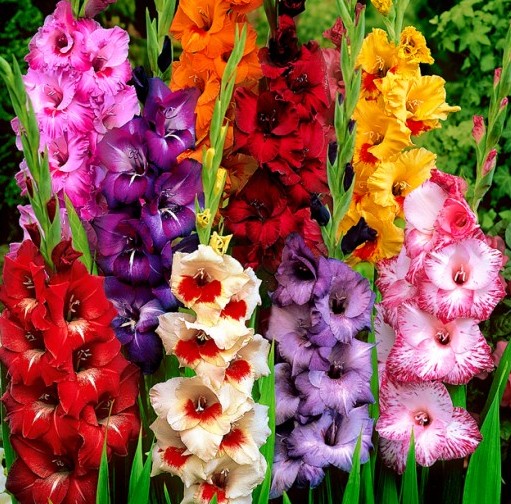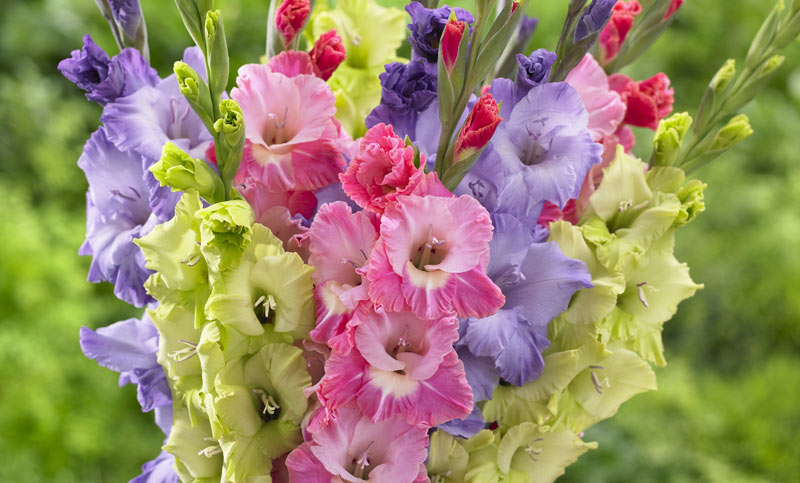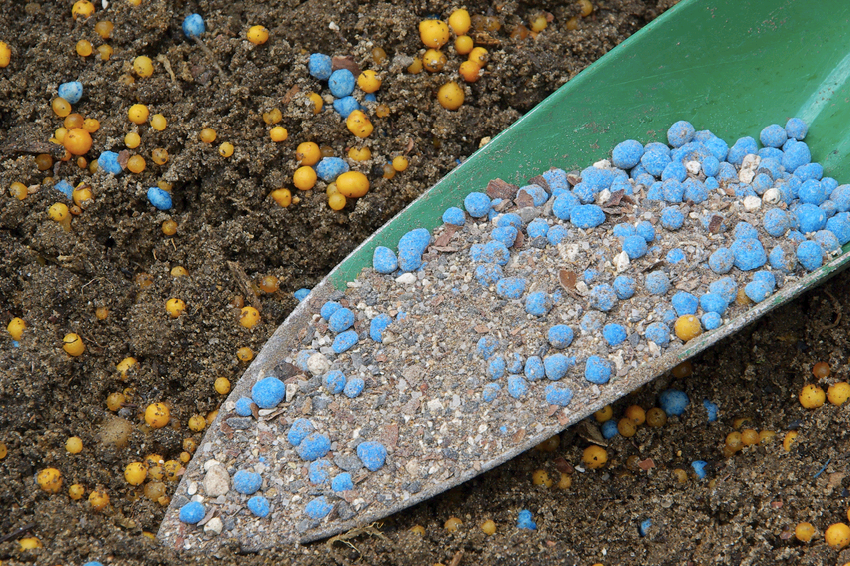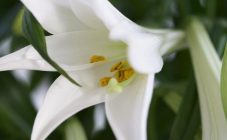Content:
Who does not remember childhood, September 1 and a huge bouquet of gladioli in their hands? These luxurious bouquets were carried by the students for the teachers. And now these beautiful flowers are pleasing to the eye in the flower beds of summer cottages. A long peduncle on which lush flowers grow is popularly called a skewer. The plant belongs to the Iris family. In nature, there are several thousand different varieties that have appeared thanks to the work of breeders from many countries of the world. So when do gladioli bloom? The answer to this question can be found in the article.
When gladiolus blooms
Many are interested in when gladioli bloom after planting? Skewers bloom, depending on:
- varieties of flowers;
- landing time;
- climatic conditions.
Flowers of early varieties begin to bloom in the last days of July, middle varieties - in the last days of August or early September. Peduncles of late varieties begin to bloom magnificently in late September - early October.
If the bulbs are planted earlier, then the plant will bloom much earlier, respectively, late planting leads to late flowering.
In order to admire the flowers in June, you need to prepare the bulbs in March. To do this, they are planted in individual pots and placed in a place where there is a lot of light. After a while, the plant will germinate and the first leaves will appear.
In this case, it is not recommended to apply fertilizers; the plant feeds on the minerals in the bulb. In the last decade of March, the germinated plant is planted in a soil preheated with a film. Before planting, you need to water the holes with a hot solution of potassium permanganate.
After two weeks, you need to plant a second batch of bulbs. After another two weeks, the remaining bulbs are planted, but they no longer need germination. Gladioli bloom only once after planting and bloom for two weeks.
Gardeners are interested in when gladioli bloom after planting bulbs of different ages? The flowering of this plant directly depends on the weather conditions, as well as on the age of the bulb. If you plant the planting material of the second year of flowering, then the skewer will bloom two weeks later than the one-year-old. Thus, if you plant bulbs of different ages, then flowering will last significantly. All the same, it will not be possible to plant them in such a way that they bloom magnificently by a certain date.
How to speed up the flowering of gladioli
In addition to sprouting bulbs, there are other ways to significantly speed up the flowering of the skewer. The planting material is soaked in a solution of trace elements and ash. The composition of trace elements should include:
- potassium permanganate 2 g,
- boric acid 3 g,
- copper sulfate 3 g,
- cobalt nitrate 1 g,
- magnesium sulfate 2.5 g,
- zinc sulfate 0.7 g.
Thus, the plant will receive the necessary nutrition in sufficient quantity to start flowering fourteen days ahead of schedule.
How to properly cut gladioli
Do I need to cut gladioli during flowering, and how long will they stand in a vase? Gladioli look very beautiful in a bouquet. But in order for them to please the eye, you need to properly cut them from the plant. Such a bouquet can stand for at least fourteen days, if at the same time cut off flowers that have already withered.
When cutting a skewer, you need to remember that the bulb must form correctly and grow "children". To do this, you must leave at least three to four leaves on the stem. In order for this condition to be fulfilled correctly, the peduncle is pierced with a garden knife, broken and carefully pulled out. This way the leaves remain intact.
Compositions from the flower skewer itself look very beautiful, but if you add other flowers to them, then gladioli will stand out brightly against their background. This addition to the bouquet can be:
- dahlias,
- godetia,
- Clarkia.
Leaves are perfect for landscaping a bouquet:
- gypsophilia,
- ivy,
- asparagus,
- young maple,
- barberry,
- cherry plums.
For large bouquets, maple or viburnum branches with fruits are used. When drawing up such bouquets, you need to remember that the plant has large flowers, and at the time of blooming they become heavy. So that the stems of the skewer do not bend or break in a vase, they are supported with special plates with thorns. They put such devices on the bottom of the vase and prick the stems on them.
The peduncle is cut off when the first flower blooms on it, or during the period of staining of the three lower buds. The vase is filled with water to the very edge, so that the stems can drink enough of it, so that the plants remain elastic for a long time.
In order for the buds to open completely, the water temperature must be warmed up to twenty or twenty-five degrees. The water needs to be changed every day, while cutting off the ends of the stems a little. Thus, the peduncle will not quickly wither and will remain fresh for a long time. Putting an aspirin tablet on the bottom of the vase will significantly prolong the life of the bouquet.
How to care for blooming gladioli
Since the peduncles of gladioli are very large in relation to their corms, and the plant does not have a large root system, they must be provided with nutrition and moisture. Watering is necessary at least once every two weeks; in dry weather, the plant needs to be watered every day.
In order for the skewers to flourish magnificently, the soil must be saturated with moisture for at least thirty-five centimeters. It is at this depth that the bulb and its root system are located. Simple superficial soil moisture is completely unsuitable for this plant. It can only lead to the development of weeds in the flower bed. To properly water, you need to pour at least one and a half buckets per square meter.
In addition to watering, the skewers must be loosened, since during watering a crust forms around the plant, which does not allow air to pass to the roots. After the soil is loosened, the plant is slightly huddled so that new grooves for watering are formed. It is necessary to loosen the soil around gladioli even after heavy downpours have passed. To have less work in the garden, you need to mulch the root zone.
Mulch helps to retain moisture in the soil, and also relieves the grower of the work of loosening the soil. Also, thanks to this soil coverage, weeds will not grow on the flower bed. For mulch, you can take:
- humus,
- peat,
- compost,
- pine needles
- grass,
- straw.
Apply it as soon as the plant grows about ten centimeters.
Weeding the skewer is done three or four times during the whole season, since loosening and mulching are activities that are carried out in order to prevent weed growth. Weeds should be removed early in the growth stage to prevent them from drowning out the flowers.
The most important thing in the care of gladioli is feeding the plant. Skaters not only cannot extract water on their own, they also find it difficult to extract minerals that are necessary for nutrition. But for these plants there are no simplified nutritional systems, so fertilizers must be applied strictly according to the stages of plant growth and development.
The first time you need to feed the flowers, as soon as they begin to develop. Due to this, the plant forms stems, leaves actively grow and develop, and the laying of peduncles begins. It is especially important for the plant to get a large amount of nitrogen during this period. But do not overdo it with this fertilizer. This can cause the plant to stop flowering.
When the plant grows up a little, during this period it will be necessary to apply fertilizers that contain phosphorus. The third top dressing is done with the introduction of potash-phosphorus fertilizers, during the budding period.
You need to know how to feed gladioli during flowering so that they bloom magnificently. If the flowers are grown specifically for making bouquets, then they are fed in six stages:
- the first top dressing is applied at the stage of formation of the first true leaves and consists of nitrogen and potassium fertilizers;
- as soon as three or four leaves grow, nitrogen and potassium fertilizers need to be applied along with boric acid;
- at the six-leaf stage, you need to feed the plant with nitrogen and potassium mineral fertilizers;
- fertilize next time when the gladiolus releases a peduncle;
- when gladiolus fades, fertilizer is reintroduced into the soil, consisting of phosphates and potassium;
- at the end, you need to water the plant with a solution of potassium permanganate.
They revitalize the plants with liquid fertilizers, since dry substances do not bring any effect.
Gladioli in the Moscow Region, Siberia and the Urals
Cultivation of gladioli is popular in many regions of Russia. In Moscow and the Moscow region, the planting of the bulb begins on the twenty-fifth of April and ends on the tenth of May. At this time, the soil has time to warm up to ten degrees, which is very favorable for the development of culture.
In the Urals and Siberia, a favorable time for planting flowers is the second decade of May. If planted earlier, the flowers will not germinate for a long time, since the soil is not yet warmed up enough.
In order for gladioli to flourish on a flower bed, they must be properly grown. First of all, you need to remember the timing of planting, then do not forget about the rules for caring for plants. Moreover, top dressing takes the first place in the care of flower queens.
















